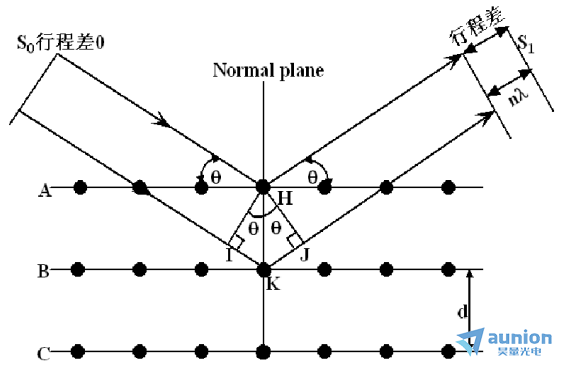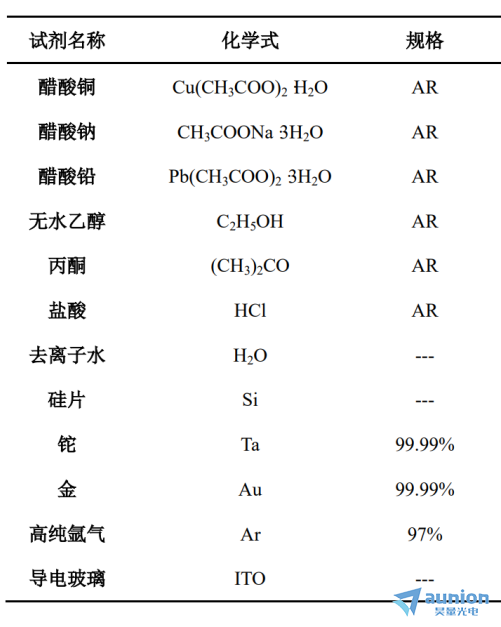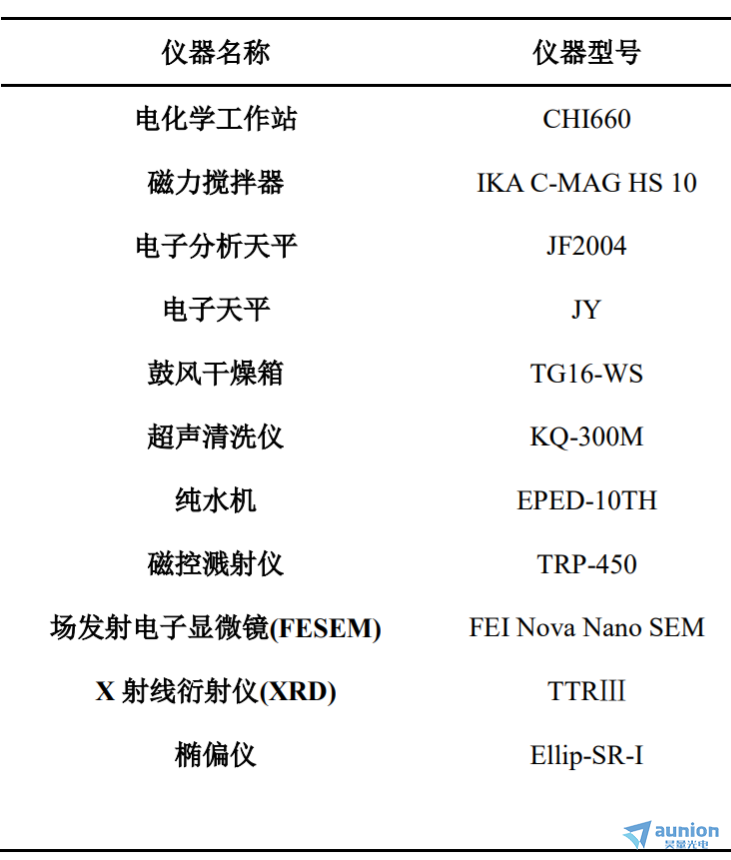

本文主要介紹了對(duì)用到的形貌和成分表征用到的儀器的原理進(jìn)行陳述续挟,其中包括掃描電子顯微鏡和X-ray紧卒。從形貌分析和成分分析入手,以及介紹了主要制備的化學(xué)試劑及表征設(shè)備诗祸。
展示全部 
橢偏儀在位表征電化學(xué)沉積的系統(tǒng)搭建(十三)- 形貌及成分
2.5形貌及成分
2.5.1形貌分析
表征樣品的形貌常用的儀器是掃描電子顯微鏡(SEM)跑芳,其原理是通過高能的電子束掃描樣品表面激發(fā)出背散射電子轴总、二次電子和X射線等信號(hào),然后對(duì)接受到的信號(hào)進(jìn)行放大并顯示成像博个,實(shí)現(xiàn)對(duì)樣品形貌等的監(jiān)測(cè)怀樟。掃描電子微鏡顯具有操作簡(jiǎn)單方便,得到的圖像清晰坡倔,zui大程度還原真實(shí)樣品形貌等優(yōu)點(diǎn)漂佩。通過掃描電子顯微鏡觀察Cu2O薄膜,得到其表面形貌與顆粒尺寸等信息罪塔,從而對(duì)Cu2O薄膜有更加直觀了解投蝉。
2.5.2成分分析
得到的樣品薄膜通過X射線衍射譜儀掃描確定其成分。X射線是一種波長(zhǎng)約為20到0.06?的電磁波征堪,利用原子內(nèi)層的電子被高速運(yùn)動(dòng)的電子轟擊產(chǎn)生躍遷光輻射瘩缆,從而產(chǎn)生氣體的電離、熒光物質(zhì)的發(fā)光以及照相乳膠感光等佃蚜。用電子束來轟擊金屬―靶‖材時(shí)將產(chǎn)生X射線庸娱,通過衍射圖譜的分析,可以獲得其成分谐算、內(nèi)部原子或者分子的結(jié)構(gòu)和形態(tài)等信息熟尉。當(dāng)X射線掃描晶體物質(zhì)時(shí),X射線因晶格間距等效光柵的存在而發(fā)生光的散射和干涉洲脂。干涉效應(yīng)使得X射線的散射強(qiáng)度增強(qiáng)或減弱斤儿,其中強(qiáng)度zui大的光被認(rèn)為是X射線衍射線。圖2-5是晶面間距是d的n級(jí)反射圖示恐锦。在布拉格公式中:

d為晶面間距往果,θ為布拉格角,λ為入射波長(zhǎng)一铅。當(dāng)入射光照射到晶面上時(shí)會(huì)發(fā)生輻射陕贮,且輻射部分將成為球面波同步傳播,其光程差是波長(zhǎng)的整數(shù)倍潘飘。一部分入射光的偏轉(zhuǎn)角度是2θ肮之,會(huì)在衍射圖案中產(chǎn)生反射點(diǎn)。通過已知波長(zhǎng)X射線測(cè)量出的θ角卜录,得到晶面間距d局骤,從而可分解析出材料的內(nèi)部原子、或分子結(jié)構(gòu)暴凑。由衍射峰的強(qiáng)度可得出晶體結(jié)晶度,再利用謝樂公式(Scherrer)即能計(jì)算出晶粒平均尺寸赘来。謝樂公式(Scherrer):

式中K是Scherrer常數(shù)现喳,如果β是衍射峰的半高寬凯傲,那么K=0.89,如果β是衍射峰的積分高寬嗦篱,則K=1冰单;D為晶粒垂直于晶面方向的平均厚度(nm);θ為布拉格衍射角灸促;λ為X射線波長(zhǎng)诫欠,λ=0.154056nm。

圖2-5X射線的晶體衍射圖
2.6實(shí)驗(yàn)主要化學(xué)試劑及設(shè)備
本小節(jié)主要對(duì)涉及到的化學(xué)試劑進(jìn)行陳述浴栽。
2.6.1主要化學(xué)試劑
本實(shí)驗(yàn)所用的化學(xué)試劑如表2-1所示:

表2-1實(shí)驗(yàn)主要化學(xué)試劑
2.6.2主要制備及表征設(shè)備
本實(shí)驗(yàn)所用的主要制備及表征設(shè)備如表2-2所示:

表2-2主要制備及表征設(shè)備
了解更多橢偏儀詳情荒叼,請(qǐng)?jiān)L問上海昊量光電的官方網(wǎng)頁:
http://www.wjjzl.com/three-level-56.html
更多詳情請(qǐng)聯(lián)系昊量光電/歡迎直接聯(lián)系昊量光電
關(guān)于昊量光電:
上海昊量光電設(shè)備有限公司是光電產(chǎn)品專業(yè)代理商,產(chǎn)品包括各類激光器典鸡、光電調(diào)制器被廓、光學(xué)測(cè)量設(shè)備、光學(xué)元件等萝玷,涉及應(yīng)用涵蓋了材料加工嫁乘、光通訊、生物醫(yī)療球碉、科學(xué)研究蜓斧、國防、量子光學(xué)睁冬、生物顯微挎春、物聯(lián)傳感、激光制造等痴突;可為客戶提供完整的設(shè)備安裝搂蜓,培訓(xùn),硬件開發(fā)辽装,軟件開發(fā)帮碰,系統(tǒng)集成等服務(wù)。
您可以通過我們昊量光電的官方網(wǎng)站www.wjjzl.com了解更多的產(chǎn)品信息拾积,或直接來電咨詢4006-888-532殉挽。
相關(guān)文獻(xiàn):
[1] WONG H S P, FRANK D J, SOLOMON P M et al. Nanoscale cmos[J]. Proceedings of the IEEE, 1999, 87(4): 537-570.
[2] LOSURDO M, HINGERL K. ellipsometry at the nanoscale[M]. Springer Heidelberg New York Dordrecht London. 2013.
[3] DYRE J C. Universal low-temperature ac conductivity of macroscopically disordered nonmetals[J]. Physical Review B, 1993, 48(17): 12511-12526. DOI:10.1103/PhysRevB.48.12511.
[4] CHEN S, KüHNE P, STANISHEV V et al. On the anomalous optical conductivity dISPersion of electrically conducting polymers: Ultra-wide spectral range ellipsometry combined with a Drude-Lorentz model[J]. Journal of Materials Chemistry C, 2019, 7(15): 4350-4362.
[5] 陳籃,周巖. 膜厚度測(cè)量的橢偏儀法原理分析[J]. 大學(xué)物理實(shí)驗(yàn), 1999, 12(3): 10-13.
[6] ZAPIEN J A, COLLINS R W, MESSIER R. Multichannel ellipsometer for real time spectroscopy of thin film deposition from 1.5 to 6.5 eV[J]. Review of Scientific Instruments, 2000, 71(9): 3451-3460.
[7] DULTSEV F N, KOLOSOVSKY E A. Application of ellipsometry to control the plasmachemical synthesis of thin TiONx layers[J]. Advances in Condensed Matter Physics, 2015, 2015: 1-8.
[8] DULTSEV F N, KOLOSOVSKY E A. Application of ellipsometry to control the plasmachemical synthesis of thin TiONx layers[J]. Advances in Condensed Matter Physics, 2015, 2015: 1-8.
[9] YUAN M, YUAN L, HU Z et al. In Situ Spectroscopic Ellipsometry for Thermochromic CsPbI3 Phase Evolution Portfolio[J]. Journal of Physical Chemistry C, 2020, 124(14): 8008-8014.
[10] 焦楊景.橢偏儀在位表征電化學(xué)沉積的系統(tǒng)搭建.云南大學(xué)說是論文,2022.
[11] CANEPA M, MAIDECCHI G, TOCCAFONDI C et al. Spectroscopic ellipsometry of self assembLED monolayers: Interface effects. the case of phenyl selenide SAMs on gold[J]. Physical Chemistry Chemical Physics, 2013, 15(27): 11559-11565. DOI:10.1039/c3cp51304a.
[12] FUJIWARA H, KONDO M, MATSUDA A. Interface-layer formation in microcrystalline Si:H growth on ZnO substrates studied by real-time spectroscopic ellipsometry and infrared spectroscopy[J]. Journal of Applied Physics, 2003, 93(5): 2400-2409.
[13] FUJIWARA H, TOYOSHIMA Y, KONDO M et al. Interface-layer formation mechanism in (formula presented) thin-film growth studied by real-time spectroscopic ellipsometry and infrared spectroscopy[J]. Physical Review B - Condensed Matter and Materials Physics, 1999, 60(19): 13598-13604.
[14] LEE W K, KO J S. Kinetic model for the simulation of hen egg white lysozyme adsorption at solid/water interface[J]. Korean Journal of Chemical Engineering, 2003, 20(3): 549-553.
[15] STAMATAKI K, PAPADAKIS V, EVEREST M A et al. Monitoring adsorption and sedimentation using evanescent-wave cavity ringdown ellipsometry[J]. Applied Optics, 2013, 52(5): 1086-1093.
[16] VIEGAS D, FERNANDES E, QUEIRóS R et al. Adapting Bobbert-Vlieger model to spectroscopic ellipsometry of gold nanoparticles with bio-organic shells[J]. Biomedical Optics Express, 2017, 8(8): 3538.
[17] ARWIN H. Application of ellipsometry techniques to biological materials[J]. Thin Solid Films, 2011, 519(9): 2589-2592.
[18] ZIMMER A, VEYS-RENAUX D, BROCH L et al. In situ spectroelectrochemical ellipsometry using super continuum white laser: Study of the anodization of magnesium alloy [J]. Journal of Vacuum Science & Technology B, 2019, 37(6): 062911.
[19] ZANGOOIE S, BJORKLUND R, ARWIN H. Water Interaction with Thermally Oxidized Porous Silicon Layers[J]. Journal of The Electrochemical Society, 1997, 144(11): 4027-4035.
[20] KYUNG Y B, LEE S, OH H et al. Determination of the optical functions of various liquids by rotating compensator multichannel spectroscopic ellipsometry[J]. Bulletin of the Korean Chemical Society, 2005, 26(6): 947-951.
[21] OGIEGLO W, VAN DER WERF H, TEMPELMAN K et al. Erratum to ― n-Hexane induced swelling of thin PDMS films under non-equilibrium nanofiltration permeation conditions, resolved by spectroscopic ellipsometry‖ [J. Membr. Sci. 431 (2013), 233-243][J]. Journal of Membrane Science, 2013, 437: 312..
[22] BROCH L, JOHANN L, STEIN N et al. Real time in situ ellipsometric and gravimetric monitoring for electrochemistry experiments[J]. Review of Scientific Instruments, 2007, 78(6).
[23] BISIO F, PRATO M, BARBORINI E et al. Interaction of alkanethiols with nanoporous cluster-assembled Au films[J]. Langmuir, 2011, 27(13): 8371-8376.
[24] 李廣立. 氧化亞銅薄膜的制備及其光電性能研究[D]. 西南交通大學(xué), 2016.
[25] 董金礦. 氧化亞銅薄膜的制備及其光催化性能的研究[D]. 安徽建筑大學(xué), 2014.
[26] 張楨. 氧化亞銅薄膜的電化學(xué)制備及其光催化和光電性能的研究[D]. 上海交通大學(xué)材料科 學(xué)與工程學(xué)院, 2013.
[27] DISSERTATION M. Cellulose Derivative and Lanthanide Complex Thin Film Cellulose Derivative and Lanthanide Complex Thin Film[J]. 2017.
[28] NIE J, YU X, HU D et al. Preparation and Properties of Cu2O/TiO2 heterojunction Nanocomposite for Rhodamine B Degradation under visible light[J]. ChemistrySelect, 2020, 5(27): 8118-8128.
[29] STRASSER P, GLIECH M, KUEHL S et al. Electrochemical processes on solid shaped nanoparticles with defined facets[J]. Chemical Society Reviews, 2018, 47(3): 715-735.
[30] XU Z, CHEN Y, ZHANG Z et al. Progress of research on underpotential deposition——I. Theory of underpotential deposition[J]. Wuli Huaxue Xuebao/ Acta Physico - Chimica Sinica, 2015, 31(7): 1219-1230.
[31] PANGAROV n. Thermodynamics of electrochemical phase formation and underpotential metal deposition[J]. Electrochimica Acta, 1983, 28(6): 763-775.
[32] KAYASTH S. ELECTRODEPOSITION STUDIES OF RARE EARTHS[J]. Methods in Geochemistry and Geophysics, 1972, 6(C): 5-13.
[33] KONDO T, TAKAKUSAGI S, UOSAKI K. Stability of underpotentially deposited Ag layers on a Au(1 1 1) surface studied by surface X-ray scattering[J]. Electrochemistry Communications, 2009, 11(4): 804-807.
[34] GASPAROTTO L H S, BORISENKO N, BOCCHI N et al. In situ STM investigation of the lithium underpotential deposition on Au(111) in the air- and water-stable ionic liquid 1-butyl-1-methylpyrrolidinium bis(trifluoromethylsulfonyl)amide[J]. Physical Chemistry Chemical Physics, 2009, 11(47): 11140-11145.
[35] SARABIA F J, CLIMENT V, FELIU J M. Underpotential deposition of Nickel on platinum single crystal electrodes[J]. Journal of Electroanalytical Chemistry, 2018, 819(V): 391-400.
[36] BARD A J, FAULKNER L R, SWAIN E et al. Fundamentals and Applications[M]. John Wiley & Sons, Inc, 2001.
[37] SCHWEINER F, MAIN J, FELDMAIER M et al. Impact of the valence band structure of Cu2O on excitonic spectra[J]. Physical Review B, 2016, 93(19): 1-16.
[38] XIONG L, HUANG S, YANG X et al. P-Type and n-type Cu2O semiconductor thin films: Controllable preparation by simple solvothermal method and photoelectrochemical properties[J]. Electrochimica Acta, 2011, 56(6): 2735-2739.
[39] KAZIMIERCZUK T, FR?HLICH D, SCHEEL S et al. Giant Rydberg excitons in the copper oxide Cu2O[J]. Nature, 2014, 514(7522): 343-347.
[40] RAEBIGER H, LANY S, ZUNGER A. Origins of the p-type nature and cation deficiency in Cu2 O and related materials[J]. Physical Review B - Condensed Matter and Materials Physics, 2007, 76(4): 1-5.
[41] 舒云. Cu2O薄膜的電化學(xué)制備及其光電化學(xué)性能的研究[D]. 云南大學(xué)物理與天文學(xué)院拓巧,2019.
展示全部 